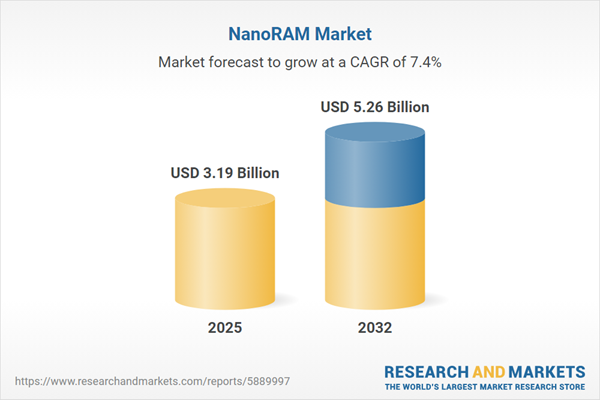Speak directly to the analyst to clarify any post sales queries you may have.
As digital transformation accelerates, the NanoRAM market is emerging as a pivotal force in enterprise memory infrastructure. Senior decision-makers rely on NanoRAM for high-speed, non-volatile storage solutions that ensure operational stability and readiness for next-generation applications.
Market Snapshot: NanoRAM Market Size and Growth Outlook
In 2024, the global NanoRAM market is estimated at USD 2.96 billion, fueled by rising demand for advanced non-volatile memory technologies. Expected to reach USD 3.19 billion in 2025 and USD 5.26 billion by 2032, the sector is growing at a strong 7.44% CAGR. This growth underscores a strategic shift among organizations prioritizing robust memory systems to achieve operational speed and resilience. The adoption of edge computing, rapid enterprise digitalization, and expanding investments in data-centric industrial and commercial infrastructure are further accelerating the integration of NanoRAM across global markets.
Scope & Segmentation of the NanoRAM Market
- Memory Types: Ferroelectric RAM, Magnetoresistive RAM, Phase Change Memory, and Resistive RAM enable persistent, real-time data retention and fast responsiveness. These features are especially relevant in industries such as automation, transportation, and utilities, driving operational reliability where immediate access and stable storage are critical.
- End Use: NanoRAM supports a wide spectrum of applications, including personal devices like PCs, smartphones, and wearables alongside servers, automation platforms, storage solutions, IoT edge devices, and smart gateways. The technology strengthens infrastructure where uptime, data integrity, and efficiency are essential, for example in digital manufacturing and smart city systems.
- End User Industries: Key industries adopting NanoRAM include automotive, consumer electronics, telecommunications, healthcare, and industrial automation. In environments ranging from robotics and medical diagnostics to remote monitoring, the ability to maintain data integrity and reliability is essential for compliance and mission-critical performance.
- Regions: Market evolution is influenced by diverse investment priorities, regulatory requirements, and digital innovation initiatives across the Americas, Europe, Middle East & Africa, and Asia-Pacific. Notably, countries such as China, Japan, South Korea, and India are advancing the adoption of NanoRAM in complex operational settings due to significant technology investments.
- Key Players: Leading participants shaping the competitive landscape include Nantero Inc., Fujitsu Semiconductor Limited, SK hynix Inc., GlobalFoundries Inc., Taiwan Semiconductor Manufacturing Company Limited, Macronix International Co., Powerchip Technology Corporation, Texas Instruments Incorporated, IBM Corporation, and Kioxia Corporation. Their collaborative efforts within the value chain support tailored deployments and sustained activity in the sector.
NanoRAM Market: Key Takeaways for Decision-Makers
- NanoRAM enables enterprises to maintain high business continuity by ensuring reliable, rapid access and stable memory performance in mission-critical environments where downtime must be avoided.
- Enhancements such as 3D memory stacking and use of advanced dielectric materials are expanding NanoRAM’s suitability for increasingly complex, latency-sensitive, and scalable industrial use cases.
- Broad deployment across diverse sectors—including healthcare, transport, and automated manufacturing—ensures stakeholders can maintain reliability and flexibility as their operational demands shift.
- Strategic partnerships between manufacturers, integrators, and solution providers are driving both innovation and market-tailored NanoRAM hardware, directly supporting the needs of high-priority sectors.
- Organizations must adapt to dynamic regulatory landscapes to preserve operational resilience and ensure their technology investments remain compliant as business environments evolve.
Tariff Impact: Navigating Regulatory Challenges
With U.S. tariffs scheduled for 2025, the NanoRAM supply chain faces new challenges in semiconductor material sourcing and compliance. Market leaders are mitigating risks by diversifying their global supplier base and forming international strategic alliances. This approach maintains supply consistency, continues innovation efforts, and allows companies to manage regulatory changes while upholding continuity and compliance standards.
Methodology & Data Sources
This report combines detailed quantitative data on the NanoRAM market with qualitative analysis from authoritative technical publications, current patents, and interviews with leading semiconductor executives. Input from a specialized technical panel ensures findings remain accurate and in line with the latest industry standards for non-volatile memory technology.
Why This Report Matters
- Provides actionable intelligence for technology and business leaders navigating evolving NanoRAM procurement, deployment, and compliance strategies.
- Facilitates strategic partnerships and informed investment choices by delivering targeted analysis on technology selection, market expansion, and risk mitigation in diverse operating environments.
- Offers a clear understanding of emerging technology trends, empowering decision-makers to respond effectively as industry and regulatory dynamics shift.
Conclusion
NanoRAM is integral to forward-looking digital strategies, supporting enterprises seeking resilient memory architectures. Robust, up-to-date market insights help organizations adapt confidently to accelerating innovation and emerging opportunities.
Additional Product Information:
- Purchase of this report includes 1 year online access with quarterly updates.
- This report can be updated on request. Please contact our Customer Experience team using the Ask a Question widget on our website.
Table of Contents
3. Executive Summary
4. Market Overview
7. Cumulative Impact of Artificial Intelligence 2025
Companies Mentioned
The companies profiled in this NanoRAM market report include:- Nantero, Inc.
- Fujitsu Semiconductor Limited
- SK hynix Inc.
- GlobalFoundries Inc.
- Taiwan Semiconductor Manufacturing Company Limited
- Macronix International Co., Ltd.
- Powerchip Technology Corporation
- Texas Instruments Incorporated
- International Business Machines Corporation
- Kioxia Corporation
Table Information
| Report Attribute | Details |
|---|---|
| No. of Pages | 183 |
| Published | October 2025 |
| Forecast Period | 2025 - 2032 |
| Estimated Market Value ( USD | $ 3.19 Billion |
| Forecasted Market Value ( USD | $ 5.26 Billion |
| Compound Annual Growth Rate | 7.4% |
| Regions Covered | Global |
| No. of Companies Mentioned | 11 |









